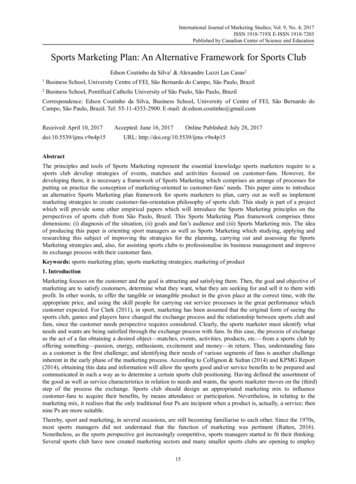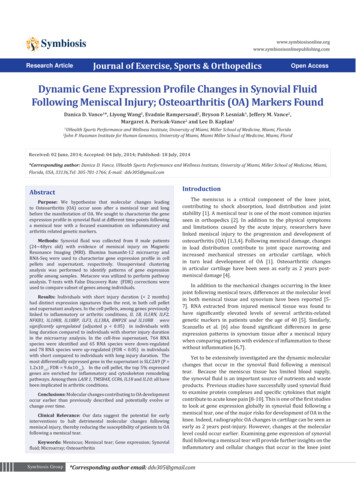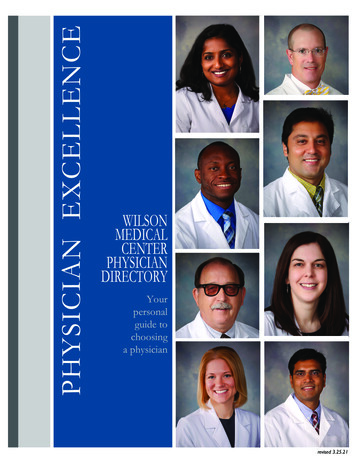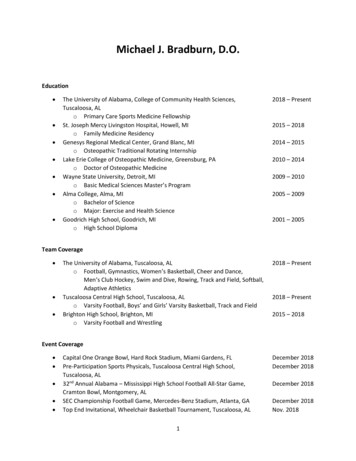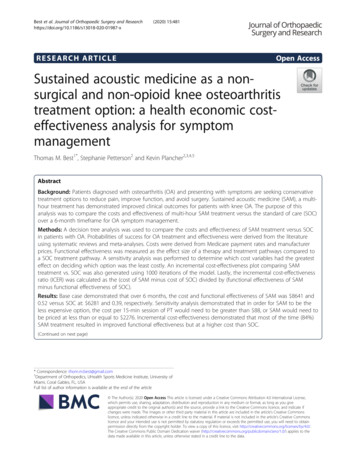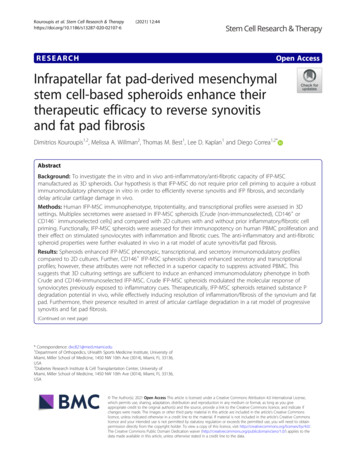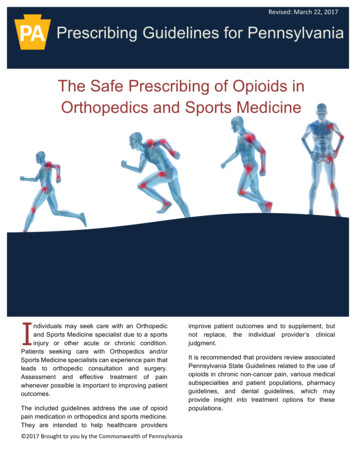
Transcription
Revised: March 22, 2017[Type here]Prescribing Guidelines for PennsylvaniaThe Safe Prescribing of Opioids inOrthopedics and Sports MedicineIndividuals may seek care with an Orthopedicand Sports Medicine specialist due to a sportsinjury or other acute or chronic condition.Patients seeking care with Orthopedics and/orSports Medicine specialists can experience pain thatleads to orthopedic consultation and surgery.Assessment and effective treatment of painwhenever possible is important to improving patientoutcomes.The included guidelines address the use of opioidpain medication in orthopedics and sports medicine.They are intended to help healthcare providers 2017 Brought to you by the Commonwealth of Pennsylvaniaimprove patient outcomes and to supplement, butnot replace, the individual provider’s clinicaljudgment.It is recommended that providers review associatedPennsylvania State Guidelines related to the use ofopioids in chronic non-cancer pain, various medicalsubspecialties and patient populations, pharmacyguidelines, and dental guidelines, which mayprovide insight into treatment options for thesepopulations.
Safe Prescribing of Opioids in Orthopedics and Sports MedicineProviders should remember that exercise (includingrehabilitative exercise), Osteopathic ManipulativeTreatment (OMT), physical therapy, acupuncture, orpsychotherapy (e.g. cognitive behavioral therapy)will often ameliorate pain and improve function. Inmany situations, these approaches should be triedfirst and only then should pharmacological agents beconsidered.BackgroundPrescription drug overdose deaths have beenincreasing at an exponential rate. The United StatesCenters for Disease Control and Prevention (CDC)reported that in 2014 over 47,000 overdose deathsoccurred in the United States, with more than 60percent (28,647) of these deaths involving opioids.In 2014, 1.5-times more people died from drugoverdoses than died in automobile accidents. InPennsylvania, the number of opioid related deaths isalso staggering. In 2015, it was reported that at least10 individuals died each day in Pennsylvania of adrug overdose.While the United States makes up only 4.4% of theworld’s population, Americans utilize 80% of theworld’s supply of opioids. Prescribing decisionsaffect not only the patient, but their family andsociety-at-large. New or occasional abusers of painmedications obtain a significant portion of theirprescription drugs for non-medical purposes throughfriends and family, rather than through legal means.As a result, even appropriately prescribed opioids fora specific patient can lead to significant harm toanother, if that person takes the pain medicationsnot prescribed to him or her.Moreover, the amount of opioids prescribed byphysicians following surgery appears to be trendingupwards. Between 2004 and 2012, opioidprescriptions increased by 18%. Further, in 2012,70% of opioid-naïve patients who had a low-risk,minor surgical procedure, filled an opioidprescription within seven days of the surgery. 2017 Brought to you by the Commonwealth of Pennsylvania 2More recent data indicates that opioid prescribingcompleted at the time of surgery may have animportant impact on the risk for both chronic opioiduse, and the risk for development of substance usedisorder.In order to address the opioid epidemic, many havecalled for more judicious prescribing on the part ofphysicians and other healthcare providers.Orthopedic surgeons are the third highestprescribers of opioid prescriptions behind familypractitioners and internists. Therefore, orthopedicsurgeons have a unique opportunity to improvepatient outcomes through best practices related toproper assessment and treatment of pain thatincludes mindful opioid prescribing.1. General Opioid Guidelines:A. Patient assessment should include propermethods for pain assessment.i.Providers should understand thatwhile patient-reported pain intensity,most commonly obtained via thenumerical rating scale (NRS), canprovide important information, it mustbe incorporated into a morecomprehensive patient assessment.ii.Opioid prescribing decisions shouldnot be based solely on the NRS painintensity report.iii.Opioid prescribing decisions shouldalso be based on functionalassessment of patients, weighingpotential benefits opioid analgesicsmay have on function againstpotential harms.B. Patients benefit most from multi-modalityanalgesia and functional improvement.i.Opioids should rarely be used as theonly analgesic. Pain care can includenon-opioid medications, regionalanesthesia, and various modalities oftherapeutic and supportive care.
Safe Prescribing of Opioids in Orthopedics and Sports Medicineii.Providers should remember thatexercise,OMT(OsteopathicManipulative Treatment) , or psychotherapy (e.g.cognitive behavioral therapy) willoften ameliorate pain and improvefunction. In many situations, theseapproaches should be tried first andonly then should pharmacologicalagents be consideredC. Patients utilizing opioids previously who presentwith a new painful condition should be advisedthat they may not experience effective paincontrol.i.The administration of higher doses ofsystemic opioids may not lead toimproved pain control.ii.Opioid-tolerant patients are atincreased risk for opioid-inducedserious adverse events when opioiddoses are aggressively increased inan effort to obtain improved paincontrol.D. Discuss pain medicine strategy with the patientat the initial encounter. As it pertains to opioids,this should include the type of opioid, time periodto weaning, and time to cessation of therapy.i.We recommend documentation ofthis discussion in the medical record.E. For inpatient care, including surgical admission,complete and document a history and physicalexamination, including thorough medicationreconciliation, and document a diagnosis andtreatment plan. Pain care starts with a diagnosisand a treatment plan that includes goals of careand clear expectations for treatment.i.Discontinuation of opioid(s), orreferral for consideration of chronicpaintreatmentshouldbeincorporated in the treatment plan. 2017 Brought to you by the Commonwealth of Pennsylvania 3F. Act 124 of 2016 dictates that when initiatingopioid pain medication treatment, practitionersmust access and document review of dataavailable through the Prescription DrugMonitoring Program (PA PDMP AWARxE)databasei.The law also mandates query of thePDMP prior to every opioid andbenzodiazepineprescription,whether a new prescription orcontinuing therapy. Every query ofthe database should be documentedin the patient’s medical record.G. There are new Pennsylvania laws as of 2016which limit the prescription of opioids in specificpopulations, which may apply to orthopedic andsports medicine prescribers:i.No practitioner may prescribe a minor( 18 years old), more than a sevenday supply of opioids, unless in thedocumented medical opinion of thepractitioner longer therapy is needed,or the opioid is for cancer, palliative,hospice, or chronic pain care. If thereis only an authorized adult in chargeof the minor (no parent or guardian)no more than a 72-hr supply may beprescribed.(Act 126 of 2016)ii.No practitioner may prescribe morethan a seven day supply of opioids toa patient seeking care in anemergency department, urgent care,or receiving care at a hospital inobservation status (greater than 23consecutive hours of onsite services,not in the emergency department,while not admitted inpatient), unlessin the documented medical opinion ofthe practitioner longer therapy isneeded, or the opioid is for cancer,palliative, or hospice care. (Act 122 of2016)
Safe Prescribing of Opioids in Orthopedics and Sports Medicineiii.No practitioner in an emergencydepartment,urgentcare,orobservation status may prescribe arefill (continuation of previous orchronic therapy) of an opioid drugproduct. (Act 122 of 2016)H. Orthopedic patients and patients with sportsinjury are at risk for opioid misuse anddependence. Opioid abuse risk factors includea personal history of addiction, history ofaddiction in the first degree relative, or history ofconcurrent psychiatric illness.i.Prior or current history of substanceuse disorder should be assessed andopioids should be used with cautionin this situation. The prescribingprovider should be knowledgeableabout resources for treatment ofopioid use disorder in theircommunity and refer patients forcollaborativemanagementasnecessary.I.In general, opioids should not be prescribed incombination with a benzodiazepine, as the useof both medications significantly increases therisk of respiratory arrest and death.i.When opioids must be used incombination with benzodiazepines,the lowest dose of opioid while stillproviding effective analgesia shouldbe used, and consideration should begiven to careful monitoring ofadequacy of ventilation.ii.Consideration should be given to theprescribing of naloxone in patientsreceiving high doses of opioids (50100mg morphine equivalents) or inthose patients receiving opioids incombination with benzodiazepines. 2017 Brought to you by the Commonwealth of PennsylvaniaJ. 4Patients should be informed that all medications,especially opioids, should be stored in a secureplace, out of the reach of children.K. When opioids are no longer necessary for theindication for which they were prescribed, theyshould be disposed of in a safe manner andshould not be stored for future use. Pennsylvaniamaintains drug take back centers. Locations fordrug take back centers can be found px2. Orthopedic Opioid Guidelines: TraumaTrauma care can represent a particular challenge topatient-partnered approach to analgesia, dependingupon the extent of the trauma. Patient stabilityremains the initial and top priority, and the approachto trauma care should remain consistent with theAdvanced Trauma Life Support (ATLS) protocol.In studies, up to 20% of adult orthopedic traumapatients seek prescription analgesia after dischargefrom multiple providers. This can speak to bothlingering disability and significant pain of trauma, aswell as the increased propensity toward opioidaddiction with heightened dosing and duration ofopioid analgesia. It is for these reasons that theorthopedic trauma provider should, after stabilizationof the patient, consider the following:A. If opioids are administered with, or in temporalproximity to, a benzodiazepine or other sedativemedication, extreme caution should be observedwith regard to respiratory and neurologiccomplication, given the risk of morbidity andmortality.B. Depending on the type and extent of trauma,consideration must be given to the sedatingeffect of opioids with regard to preserving thevalidity of neurologic assessments. To this end,we refer you to the general guidelinesrecommending the lowest dose of opioid whilestill providing effective analgesia, adopting a
Safe Prescribing of Opioids in Orthopedics and Sports Medicinemulti-modal analgesia plan, and continuingcareful monitoring.C. Orthopedic providers managing patients whosustain trauma, injury, or fracture should observethe guidelines outlined. Clear expectationsregarding injury severity, recovery, and painmanagement should be conveyed to the patient.3. Orthopedic Opioid Guidelines: Pre-and PostOperative Care Sports Medicine Care and PostSurgical CareOrthopedic care can be divided into the preoperative, intra-operative, and post-operative timeframes, however the vast majority of opioidmedication prescribed by orthopedic surgeons is inthe immediate post-operative period. The followingare recommendations for appropriate opioid use inthese settings:A.Patients with a history of chronic opioid usewho successfully wean off their opioid dose prior toorthopedic surgery have an improvement in clinicaloutcomes that is comparable to patients who havenever used pre-operative opioid analgesia. Ifpossible, surgeons should discuss weaning opioiddosing in the pre-operative setting.B.Enhanced Recovery After Surgery (ERAS)Protocol: The use of a multi-modal approach allowspatients to use fewer opioids and spend fewer daysin the hospital. ERAS protocols have been shown tofacilitate faster recovery and improve pain controlwhile minimizing opioid use in the immediate postoperative period.i.An ERAS protocol often includes theuse of regional anesthetic techniquesintra-operatively (and continued into thepost-operative period when possible),anti-inflammatory medications when notcontraindicated, scheduled use ofacetaminophen,neuro-modulatingmedications such as gabapentin or 2017 Brought to you by the Commonwealth of Pennsylvaniapregabalin,opioids.andlimited 5systemicC.Prior to performing any tions with their patients to set realisticexpectations of pain control in the post-operativeperiod.i.Patients should understand that theywill indeed experience some amount ofpain, and that pain cannot be completelyeliminated following surgery. This isespecially true in patients on ideration for regional anesthetic or indwellingnerve catheters. The preoperative use of a regionalanesthetic may obviate the need for opioids duringthe case and significantly improve pain in the earlypostoperative period.The use of indwellingcatheters in terms of spaces outside of the joint (e.g.a scalene or femoral catheter) may significantlyreduce the need for perioperative narcotics.E.Most patients will require opioids for a shortduration of time post-operatively.i.The dose and duration of opioid therapyshould be carefully determined based onthe type of surgery and the expectedduration of need for aggressive pain care.Extended opioid use following trauma orsurgery may contribute to the chronic useof opioids or substance use disorder.ii.Many practitioners continue the use oflow-dose aspirin in consideration for DVTprophylaxis following that time period,which may additionally assist with themanagement of postoperative pain.iii.CDC pain guidelines state that opioidsshould be discontinued in most patientswithin seven (7) days. Opioid tolerance isoften present following continued dailyuse beyond two (2) weeks. Practitioners
Safe Prescribing of Opioids in Orthopedics and Sports Medicinemust take extreme care to avoid allowingacute opioid prescription to “evolve” tochronic opioid therapy.F.Many orthopedic procedures are minimallyinvasive and patients may require little or no opioidsfollowing surgery. Prescribers should use the lowestdose and amount of opioid while still providingeffective analgesia, to limit opioid excess within thecommunity.4. Orthopedic Opioid Guidelines: SportsMedicine Surgical CareSports medicine practice can (depending onspecialty) include both surgical and non-surgicalcare. For surgical guidelines, please refer to theabove orthopedic guidelines; the below will focus onambulatory and team-based sports medicine.A. There is no need for sports medicine specialists toprescribe opioids for the treatment of chronic pain.i.Patients determined to have need forchronic opioids should be referred fortreatment in a more continuity-basedenvironment, such as their primarycare provider or a pain managementspecialist.B. Non-operative treatment of sports medicineinjuries may require the use of opioids for acutepain (e.g. non-operative treatment of fractures,treatment of dislocations or acute injuries incontact sports).i.Regarding this setting, opioids shouldbe provided for limited, short-termuse, referencing the above generalconsiderations.C.Avoid the use of sustained release opioids ifpossible. Even the most painful sports medicineinjuries and surgeries can be managed withimmediate-release opioids to avoid abuse issuessurrounding sustained-release formulations.D.While it is known that non-steroidal antiinflammatory medications may negatively affectsoft tissue healing to bone as well as bony healing,it is reasonable to include NSAIDs in the shortterm (up to 7-10 days post-operatively). 2017 Brought to you by the Commonwealth of Pennsylvania 6Orthopedic surgeons should carefully weigh thebenefits of NSAID’s in the immediate postoperative period with the risk to bone healing ineach clinical scenario.E.Some patients may benefit from judicious useof as-needed opioids to allow for participation inphysical therapy or rehabilitative exercise.i.Several procedures, particularly ofthe shoulder, may necessitate aperiod of rest followed by the start ofphysical therapy or rehabilitativeexercise, where an increase level ofpain may require the use of opioids.ii.As-needed opioids to facilitatetherapy should be provided forlimited, short-term use, and a date fordiscontinuation of opioids should bedocumented and discussed with thepatient.F. Regarding return to play (RTP), consider thefollowing tenets in prescribing behavior:i.If the injury is painful enough for anopioid medication to be considered,particularly in an adolescent oramateur athlete, return to sportsshould likely not be considered.ii.Opioid medications should not beused for the purpose of returning anyathlete to the field of play.G.Per NCAA recommendation, school-basedproviders and programs should develop a writtenpolicy on substances, including opioids, thatincludes wording on recruitment, drug testing,disclosure of medications, discipline, andcounseling/treatment options.i.Student-athletes should also becounseled on the risk of combiningopioids with alcohol, particularlygiven the increased prevalence ofbinge drinking in the student-athletepopulation.H.Physicians who travel with teams to differentstates, or who sustain their practice in differentstates, should be aware of and comply with allapplicable federal and state laws regarding theprescription of opioid analgesia.
Safe Prescribing of Opioids in Orthopedics and Sports Medicinei. 7For example, if you are aPennsylvania-boardedsportsmedicine provider, traveling with yourteam to New Jersey, we recommendyou follow federal and New Jerseyguidelines, and vice versa.Pennsylvania Orthopedic Society – Opioid Recommendationsfor Acute paedic-practiceI. Post-acute injuries and recovery can create a riskof development of adverse impacts andsubstance use disorder. Referrals to counseling,as needed, can support the feelings of anxietyand depression that surround the short or longterm change in functional abilities associated withinjury, can help prevent substance misuse andintervene with development of substance usedisorder.Nguyen, Long-Co L., David C. Sing, and Kevin J. Bozic."Preoperative Reduction of Opioid Use Before Total JointArthroplasty." The Journal of Arthroplasty 31.9 (2016): 282-87.Web.Matava, Matthew J. "Ethical Considerations for Analgesic Usein Sports Medicine." Clinics in Sports Medicine 35.2 (2016): 22743. Web."2014-15 NCAA Sports Medicine Handbook." 2014-15 NCAASports Medicine Handbook. Ed. John T. Parsons. NationalCollegiate Athletic Association, Aug. 2014. Web. 15 Dec.2016.Zarling, Bradley J., Sanar S. Yokhana, Darren T. Herzog, andDavid C. Markel. "Preoperative and Postoperative Opiate Useby the Arthroplasty Patient." The Journal of Arthroplasty 31.10(2016): 2081-084. Web.Safe Emergency Prescribing Act, Act of Nov. 2, 2016, P.L. 976,No. 122.The Achieving Better Care by Monitoring All PrescriptionsProgram (“ABC-Map”), Act of Nov. 2, 2016, P.L. 980, No. 124.Safe Opioid Prescription, Act of Nov. 2, 2016, P.L. 987, No.126ResourcesAuthors: Michael Ashburn, MD, MPH, Department of Anesthesiology and Critical Care, University of Pennsylvania Maria Battista, J.D., Ed.D., Hearing Examiner, PA Department of State, Office of Hearing Examiners Jonathan P. Bigley, Esquire, Bigley & Blikle, LLC Sarah Newman Boateng, Special Assistant to the Physician General, PA Department of Health Robert Cabry, Jr., MD, FAAFP Premier Orthopedic and Sports Medicine Associates Maureen Cleaver - Director, Division of Prevention and Intervention – PA Department of Drug and Alcohol Programs Jeremy D. Close, MD - Physician - Thomas Jefferson University Jessica Deary, Patient Advocate Justin S. Hong MD, Assistant Clinical Professor, Department of Physical Medicine and Rehabilitation, Penn State College of Medicine Michael Madden, Chief Medical Officer, Gateway Health Plan Rachel Levine, MD, Physician General, Commonwealth of Pennsylvania Kenneth Martz, PsyD MBA, Special Assistant to the Secretary, PA Department of Drug and Alcohol Programs Meghan McNelly, Pharm.D., MHA, Director of Pharmacy, OSS Health Zachary F. Meisel, MD, MPH. Assistant Professor of Emergency Medicine, University of Pennsylvania Samir Mehta, MD, Orthopaedic Trauma, University of Pennsylvania Tanya Miller, GAC Chair, Pennsylvania Athletic Trainers' Society Douglas Phelan, Physician, NH Dartmouth Family Medicine Residency / PA DOH Intern Joshua Port, Physician, University Orthopedics Center Spence Reid, MD Physician, Penn State Hershey Bone and Joint Institute George Roberts, President, Pennsylvania Athletic Trainers’ Society Angela Rowe, Physician, University Orthopedics Center Robin Rothermel, Senior Director, Physician Support, Pennsylvania Medical Society Heather Shultz, Acupuncturist, Virtua Center for Integrative Medicine Patrick N. Smith, MD, Three Rivers Orthopedics, UPMC – St. Margaret Hospital, President – Pennsylvania Orthopedic Society Suzette Song, Physician, OSS Health Deborah Ann Shoemaker, Executive Director, Pennsylvania Psychiatric Society 2017 Brought to you by the Commonwealth of Pennsylvania
2017 Brought to you by the Commonwealth of Pennsylvania ndividuals may seek care with an Orthopedic and Sports Medicine specialist due to a sports injury or other acute or chronic condition. Patients seeking care with Orthopedics and/or Sports Medicine specialists can experienc
